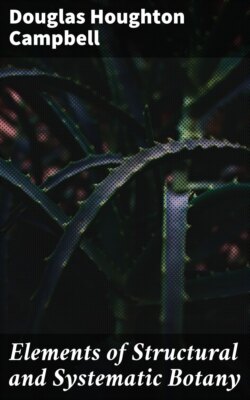Читать книгу Elements of Structural and Systematic Botany - Douglas Houghton Campbell - Страница 26
Class I.—Phycomycetes.
ОглавлениеThese are fungi consisting of long, undivided, often branching tubular filaments, resembling quite closely those of Vaucheria or other Siphoneæ, but always destitute of any trace of chlorophyll. The simplest of these include the common moulds (Mucorini), one of which will serve to illustrate the characteristics of the order.
If a bit of fresh bread, slightly moistened, is kept under a bell jar or tumbler in a warm room, in the course of twenty-four hours or so it will be covered with a film of fine white threads, and a little later will produce a crop of little globular bodies mounted on upright stalks. These are at first white, but soon become black, and the filaments bearing them also grow dark-colored.
These are moulds, and have grown from spores that are in the atmosphere falling on the bread, which offers the proper conditions for their growth and multiplication.
One of the commonest moulds is the one here figured (Fig. 32), and named Mucor stolonifer, from the runners, or “stolons,” by which it spreads from one point to another. As it grows it sends out these runners along the surface of the bread, or even along the inner surface of the glass covering it. They fasten themselves at intervals to the substratum, and send up from these points clusters of short filaments, each one tipped with a spore case, or “sporangium.”
For microscopical study they are best mounted in dilute glycerine (about one-quarter glycerine to three-quarters pure water). After carefully spreading out the specimens in this mixture, allow a drop of alcohol to fall upon the preparation, and then put on the cover glass. The alcohol drives out the air, which otherwise interferes badly with the examination.
The whole plant consists of a very long, much-branched, but undivided tubular filament. Where it is in contact with the substratum, root-like outgrowths are formed, not unlike those observed in Vaucheria. At first the walls are colorless, but later become dark smoky brown in color. A layer of colorless granular protoplasm lines the wall, becoming more abundant toward the growing tips of the branches. The spore cases, “sporangia,” arise at the ends of upright branches (Fig. 32, C), which at first are cylindrical (a), but later enlarge at the end (b), and become cut off by a convex wall (c). This wall pushes up into the young sporangium, forming a structure called the “columella.” When fully grown, the sporangium is globular, and appears quite opaque, owing to the numerous granules in the protoplasm filling the space between the columella and its outer wall. This protoplasm now divides into a great number of small oval cells (spores), which rapidly darken, owing to a thick, black wall formed about each one, and at the same time the columella and the stalk of the sporangium become dark-colored.
When ripe, the wall of the sporangium dissolves, and the spores (Fig. 32, E) are set free. The columella remains unchanged, and some of the spores often remain sticking to it (Fig. 32, D).
